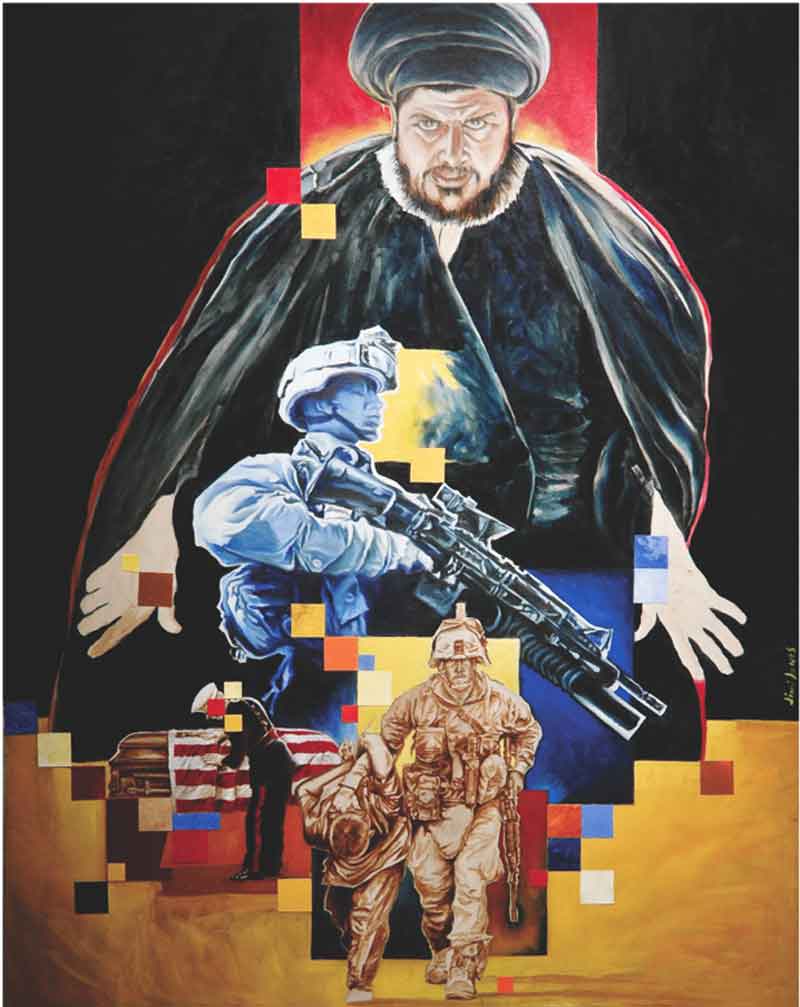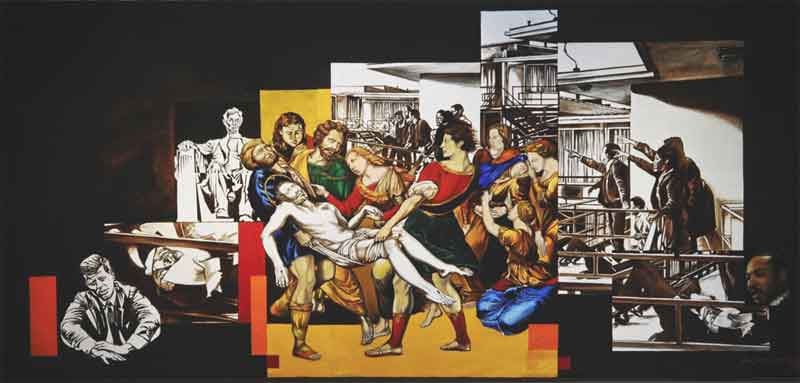ART FOR A BETTER WORLD
by Saad Ghosn
- Images For A Better World: Jimi JONES, Visual Artist
Jimi Jones, a Cincinnati artist and graphic designer, was born in Asheville, North Carolina; he lived, however, most of his life in Ohio. A graduate of the University of Cincinnati College of Design, Architecture, Art and Planning, he worked at General Electrics, then at Procter and Gamble where, for 27 years and until he retired, he served as art director in charge of display design. He is a founding member of the Neo-Ancestralist art movement. Jones has exhibited his work widely in galleries and museums, including the Contemporary Arts Center in Cincinnati, the National African American Museum in Wilburforce, Ohio, and The Cincinnati Arts Consortium. He was awarded 1st place at the 2012 Springfield Art Museum juried show.
Through his paintings, Jones documents the times we live in. He uses the Old Masters’ technique of mixing and applying colors, and combines it with the modern concept of pixels as a building block on how to see art. In doing so, he uses current events and couples them with historical references.
Jones acknowledges that millions of pixels are needed to provide meaningful information and recognizable images on a computer screen and that, viewed up close, a pixel by itself has no meaning. Unlike individual pixels, however, he wants each of his paintings to stand alone; but also similar to individual pixels, he would like each to be part of a much bigger concept. A million thoughts about the world run through Jones’ head each day; like pixels, he combines them and interprets them in his paintings.

‘Night watch’ is based on a Rembrandt painting. Unlike the parading, non-fighting, citizen soldiers in Rembrandt’s painting, the guard men in Jones’ painting really fight. The kids he depicted, he felt, held the key to stopping the conflict in the Middle East.

Jones painted ‘Crossing the Delaware’ at the time of Obama’s 2nd presidential elections. He felt then that the Tea Party was to Obama what the Delaware River had been to Washington; that Washington won and that Obama, therefore, had to win.

Commenting on his painting ‘From John Wayne to lil Wayne’, Jones states: “‘Who Is the Real Cowboy’ is about how time can ease and replace the history of a people, how the Old West is depicted with our black people. With all the inner city shootings, we will finally earn the title of URBAN Cowboys.”

- The Death of Innocents/Innocence, oil painting
“I’m innocent of the murder of Christ – I was trying to protect my power
I’m innocent of the murder of Muslims – I was only trying to protect my religion
I’m innocent of the murder of Trayvon – I was only trying to protect my community
I’m innocent of the murder of innocence – I was only trying to protect my world.”

Old men start wars. They make it sound so good and noble, but they never let the people see the caskets of the young soldiers who die so that the old men can feel like heroes. One of the most important things an artist can do is to use art to demonstrate the high price society pays in both money and lost lives for old men’s vanity.

Martyrs make civilization civil. Jesus gave his life for all people. Lincoln, Kennedy, and Dr King lost their lives because they dared to stand against slavery, injustice and inequality. Much of the great art of all time has been dedicated to reminding people of those sacrifices. Jones feels honored that as an artist he can carry on this tradition.
- Words For A Better World: Sherry STANFORTH, Literary Artist
Sherry Cook Stanforth is the Creative Writing Vision Program Director at Thomas More College and co-editor of Pine Mountain Sand & Gravel. She teaches fiction, poetry, environmental and ethnic literatures and folklore. Her work appears in various journals and anthologies and NCTE books. She performs Appalachian folk music in a family band, Tellico, named for her father’s Cherokee ancestry and childhood home. She writes music, hikes, studies plants and bugs, and conducts tapas and soup-making experiments in her kitchen every fall. She also raises bees and four children.
Growing up within the jam circles of festivals, porches and campgrounds has inspired Stanforth’s writing and teaching methods. Her narrative-driven short stories, songs and poems feature a strong appreciation for how the natural world offers people wisdom for interpreting their own powers of destruction, struggle and continuance. With her students, she spends time walking (playing) in the woods and fields of the Ohio River Valley; she also joins them in exploring the value of kitchen table talk, remembrances and storytelling offered by family members and elders in the local community. By embracing her Appalachian heritage—especially the unique features of its landscapes and narrative expressions—she hopes to inspire people to slow down and reflect about the paths they might take in these good and challenging times.
- Stanforth wrote “Dog Day Cicada” for her youngest daughter, Aubrey, who expressed both fascination and grief about a spider preparing to eat a bug. Their family spends a lot of time outside in nature so her daughter’s tearful reaction surprised her until she remembered her own struggle to both weave and escape the web.
Dog Day Cicada
When the web quivered she
snapped off a switch of green,
to sweep it all away. No, no,
I told her—just be still
and you’ll see the simple
circle spun around
every living thing.
She cried. The cicada buzzed
and quarreled with the strings
jailed from the sloped bough
of the ash. Why? she asked,
eyes on the spider carrying out
its fatal task. She shuddered,
poking at the fat blackness
centered to bite, asked how
such bloodlust could ever be
right. I said, well, we all eat
to live. Claimed the ache
to be my own and hers, too:
gulps of meat and milk,
oil and coal and war.
Everywhere you look,
there’s the web, I said.
How will you escape it?
She dropped her stick
into the muddy ditch, dried
her eyes. We stood there
while the story spun to its end—
by and by the cicada died.
- The people on Stanforth’s father’s side come from the mountains—they had few resources but a strong sense of family identity. “Lost Claims” reflects the binding tie of land and people, despite the onslaught of industry upon small communities. While some of the details of the piece are not biographical, the lost home place is very real in many Appalachian families and Stanforth’s Great Aunt Ruth (a mesmerizing storyteller) has inspired her way into many of Stanforth’s poems.
Lost Claims
Mica glitters in the driveway’s
red ruts, snowbush heads
bow down, brush the dust
peppering windows, tables,
every corner of the place.
“My heart’s gone thick,” she says,
picking burrs from Old Ted’s
scruff. “The beats off pace
and once I’m three hours dead
they’ll storm this hill to take
this land.” I ask her why,
claim that I don’t understand.
I note the boundary line,
her trees—pin cherry,
hemlock, one suffering ash
split by lightning years ago.
“That’s yours, Aunt Ruth.”
Still she says “No,” and smiles,
smacks the dog’s coarse rump
ordering him to steer clean away
from prickle vines and trouble.
I argue—but I think I know
that hemlock waits to be
a stump, her house and yard
a history gone to rubble.
- In July of 2004, Stanforth taught a CCSA creative writing course in Ireland. The West Clare countryside haunted her with its yawning green hills, stone famine walls and a history of injustice. At the time, she was pregnant with her last child, Elias, and especially tuned in to the importance of nourishment and growth. The starvation and governmental oppression that the Irish endured shocked her—when she left for home, “A Field of Crows” had already sparked in her journal as a reminder to deepen her understanding of their struggle.
A Field of Crows
They cut the sky in a line of black
bullets. Passing, they memorize
each hooked tree, the thatched
bothies and Liscannor stone walls
carving puzzles into the tumbled down
slopes. The Burren exhales wind-
smacked, tired ghosts, each rising
to reclaim a famine penny gone
unpaid. They sing as they sang
in living work—of birds winging,
boats sailing, thickest chains sparked
apart by blood and sweat. Bleached
dolmens keep their secrets and turf-torn
bogs hide their bones. Each sheer cliff
wails the old keenings, reminding folks
that losing repeats itself stone by stone,
acre by acre. Trace that line of men
stooped low among the hills, hungry
and waiting—hell-bent on flight.
- People know Stanforth as a cup-as-half-full person, always looking for the gift to come from struggle. She wrote “Accident” shortly after her students and herself experienced some powerful testimonials by Eastern Kentuckians regarding the devastation that mountaintop removal had upon their lives. While the industry operated in an exemplary democratic country, the descriptions of their experiences—from small verbs to elaborate metaphors—reminded her of war. This poem is her “playful” interpretation of people making progress in their lives.
Accident
They say
every accident
has its purpose—
the spilt coffee
only a first degree
burn and a chance
to show your thighto a fellow
human being.
There’s the baby
toddling right
into the hearth
head smacking
unforgiving limestone:
three little stitches
then a juicy grape
Dum-Dum sucker
for the road.
Make-do car totaled
out in the rush hour
bumper-bang pile up:
no injuries, new wheels.
Sick pets retching,
pissing up the rug
until the vet’s kind
needle eases them
down—why not
let a new puppy
lick away grief?
Accident of marriage
until another hero
wisks her away
from the mess
Accidents may
happen at work
yet the firing, pink
slip is your ticket
out of daily hell.
Slip up in lust
Still, nine months
will wax a baby
singing down stars
coo by coo.
Things fix, straighten
out—even the sycamore
could be an accident
of white arms
thrust sky high,
a miracle sprung
from one tiny
little seed:
voilá! here
you see
this mighty
tree
before
its
fall,
before
a lightning strike
or chainsaw
snarling tooth
over trunk.
Imagine trees—
people, mountains—
we are kissed
by wet fog
and good luck,
standing rooted
and reaching
for God knows
what’s bound
to come: black
blast, rubble flung
to rip-root-rock
unhinging a sky
from its horizon.
Mountain gone,
soldier fallen,
forest torn, creek
churned to silt,
cup tipped
the water spilt—
this, our purpose.
- Stanforth’s interpretation of how we must assess our methods for achieving progress in our search for energy and industrial rule is reflected in the poem “This Time.” She knows that coal helped her to generate the text for this poem and that it has kept her children warm in the winter. But it is not clean. Can we break a spine or bleed an artery with peace in our hearts?
This Time
For Danny Miller
That story you sometimes hear tell of
tells itself again: a woman living
in the green land that spawned her steel-
spined movements demands the end
translation—no man no more will live
to rip her tight seams or strip
the laurel hell or collapse the wells
she once divined inside an hour
of need. No tree, no bent weed
ever escapes her parched gaze.
So she grows into a snaking briar,
a wailing haint, a mountain
sprung right out of her own fill
to suck back blast and boulders.
She will reclaim each bit of ash leaf
and the little wet copse of birches
draped to be a shady-sighing cradle
to warblers, trembling shrews.
When he pushes in to cut
she strikes back, then packs up
her skipping stones, grottoes
and strange-spotted beetles
scuttling the felled logs. Mud
puppies flip inside her veins
and she flexes glowing ginseng.
This, her life…the way to be
tall. Tall, they used to whisper
in her ear. She carries tall
inside her heart, despite her tears.
Everything in its place—even
that ridge, her hardest bone,
will not be broken twice.